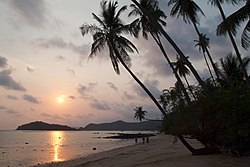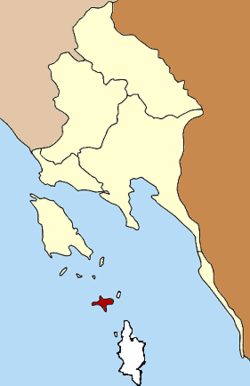| This article is written like a travel guide. Please help improve the article by introducing an encyclopedic style or move the content to Wikivoyage. (June 2019) |
Subdistrict in Trat, Thailand
| Ko Mak เกาะหมาก | |
|---|---|
| Subdistrict | |
 | |
 Subdistrict location in Trat province Subdistrict location in Trat province | |
| Coordinates: 11°49′10″N 102°28′42″E / 11.81944°N 102.47833°E / 11.81944; 102.47833 | |
| Country | Thailand |
| Province | Trat |
| District | Ko Kut |
| Time zone | UTC+7 (ICT) |
| Postal code | 23120 |
| Geocode | 230504 |
Ko Mak (Thai: เกาะหมาก, pronounced [kɔ̀ʔ màːk]) is a small island of Trat province, Thailand. It is a subdistrict (tambon) of Ko Kut district. The island is named after the areca nut (หมาก), also known as the "betel nut".
History
The first settler on the island was Chao Sua Seng, a Chinese Affairs Officer during the reign of King Rama V, who established a coconut plantation. He sold the plantation to Luang Prompakdii, also a Chinese Affairs Officer whose descendants still own the land to this day. Luang Prompakdii and his children are known to have established more coconut and rubber plantations, effectively covering most of the arable land in these two sought-after exports.
The first attempt at attracting a tourism market was in 1974, when bungalows were built at Ban Ao Nid on the east of the island. Infrastructure, specifically transport and telecommunications were in their early stages and as a result, the tourism industry on Ko Mak took some time to become established. By 1987 certain beaches and land were cleared and the first resorts were built.
Originally the area of the Ko Kut district was part of the subdistrict (tambon) Ko Chang, Laem Ngop District. In 1952 the subdistrict Ko Mak was established covering the whole island, at that time divided into four villages (mubans). In 1980, three villages of Ko Mak were split off to create the subdistrict Ko Kut. On 1 April 1990 the government upgraded tambon Ko Kut together with tambon Ko Mak to a minor district (king amphoe).
On 15 May 2007, all of Thailand's 81 minor districts were upgraded to full districts. On 24 August the upgrade became official.
As local government entities, two tambon administrative organizations (TAO) were created in 2003 and 2004 respectively. The Tambon Council Ko Kut was upgraded to a TAO in 2003, and for Ko Mak in 2004.
Geography
The island of Ko Mak is in the east of the Gulf of Thailand, 35 kilometers from the mainland, and is the third largest island in Trat Province, after Ko Chang and Ko Kut. With an area of 16 square kilometers, Ko Mak has 27 km of coastline, many long sandy beaches, and a few hills. The island is home to approximately 400 locals and renowned for its beautiful beaches, having been included in the UK's Sunday Times 10 most beautiful beaches list in 2006. Ko Mak has a temple, a primary school, three fishing villages, a market, and a health center.
It is possible to walk to Ko Kham, a smaller island less than 1 km northwest of Ko Mak during low tide.
Tourism
The island is small and flat with coconut plantations and mangrove vegetation along the coastline. There are approximately 15 small scale resorts on Ko Mak. Both Ko Kham and Ko Phi can easily be reached with sea kayak or boat rental from the resorts on the northwest coast and are snorkeling destinations.
Ko Mak has no pubs, bars with noisy music at night, or liquor stores. The campaign of use less plastic is promoted and plastic can be recycled. Locals encourage tourists to collect trash from the beach every Saturday as part of Ko Mak's Trash Hero activities.
The descendants of the five original families of Ko Mak still live on the island. The occupations of those ancestors was collecting mak ling (Areca triandra), and cultivating coconut and rubber plantations.
Gallery
-
 Hills on the west side
Hills on the west side
-
 Palms on the beach
Palms on the beach
-
 Coconut palm plantation in the south
Coconut palm plantation in the south
-
 Western beach at low tide
Western beach at low tide
-
 Shallow waters of the Gulf of Thailand, eastern lagoon
Shallow waters of the Gulf of Thailand, eastern lagoon
See also
References
- ^ "Koh Mak History". Kohmak. Retrieved 22 June 2019.
- ประกาศกระทรวงมหาดไทย เรื่อง ตั้งและเปลี่ยนแปลงเขตตำบลในท้องที่อำเภอแหลมงอบ จังหวัดตราด (PDF). The Royal Gazette (in Thai). 69 (43 ง): 2008–2009. 8 July 1952. Archived from the original (PDF) on 24 May 2012.
- ประกาศกระทรวงมหาดไทย เรื่อง ตั้งและเปลี่ยนแปลงเขตตำบลในท้องที่อำเภอแหลมงอบ จังหวัดตราด (PDF). The Royal Gazette (in Thai). 97 (150 ง): 3391. 30 September 1980. Archived from the original (PDF) on 24 May 2012.
- ประกาศกระทรวงมหาดไทย เรื่อง แบ่งเขตท้องที่อำเภอแหลมงอบ จังหวัดตราด ตั้งเป็นกิ่งอำเภอเกาะกูด (PDF). The Royal Gazette (in Thai). 109 (25 ง): 1351. 13 February 1990. Archived from the original (PDF) on 26 January 2009.
- แถลงผลการประชุม ครม. ประจำวันที่ 15 พ.ค. 2550 (in Thai). Manager Online.
- พระราชกฤษฎีกาตั้งอำเภอฆ้องชัย...และอำเภอเหล่าเสือโก้ก พ.ศ. ๒๕๕๐ (PDF). The Royal Gazette (in Thai). 124 (46 ก): 14–21. 24 August 2007. Archived from the original (PDF) on 30 September 2007.
- ประกาศกระทรวงมหาดไทย เรื่อง จัดตั้งองค์การบริหารส่วนตำบล (PDF). The Royal Gazette (in Thai). 120 (พิเศษ 146 ง): 20. 22 December 2003. Archived from the original (PDF) on 28 May 2012.
- ประกาศกระทรวงมหาดไทย เรื่อง จัดตั้งองค์การบริหารส่วนตำบลเกาะหมาก กิ่งอำเภอเกาะกูด จังหวัดตราด และองค์การบริหารส่วนตำบลวังประจัน อำเภอควนโดน จังหวัดสตูล (PDF). The Royal Gazette (in Thai). 121 (พิเศษ 64 ง): 7–8. 9 June 2004. Archived from the original (PDF) on 24 May 2012.
- "Ko Mak_Thailand". Thailand.com.co. 18 December 2011. Archived from the original on 3 March 2016. Retrieved 9 August 2014.
- "Koh Mak: Thailand's Best Kept Secret". Goodtime-resort.com. 20 June 2014. Archived from the original on 11 July 2019. Retrieved 9 August 2014.
- "Trash Hero Ko Mak". Trash Hero. Retrieved 23 June 2019.
- ^ Chuchuay, Jariya; Bupphapibul, Teerapat (May 2019). "เกาะหมาก – เกาะขาม ดินแดนที่ไม่ปรากฏบนแผนที่โลก" [Ko Mak Ko Kham, the beauty of being authentic]. Osotho Magazine (in Thai). 59 (10). Tourism Authority of Thailand (TAT): 50–61. ISSN 0125-7226.
External links
 Ko Mak travel guide from Wikivoyage
Ko Mak travel guide from Wikivoyage